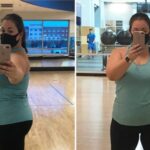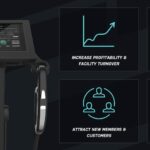
How to understand and explain body scan results: The Evolt 360 Body Scan results contain powerful metrics so it’s important to be able to understand and explain body scan results fully. As with all forms of body composition, the technology of bioelectrical impedance (BIA) requires standardised conditions when scanning to provide proper repeatability of measurements. The technology reads impedance and reactance of tissue at a point in time which can differentiate Lean Body Mass from Body Fat Mass.
The human body is quite dynamic in response to training stimulus, nutrient partitioning and supplementation/medications so those things need to be taken into account with respect to scan readings. The technology is validated in science and used in medicine so generally, variabilities in scan results are mostly due to human factors, this is why we always ensure there are standardised conditions around testing.
The most important aspect of using BIA technology is to ensure the circumstances around comparison scans are controlled, so all scans need to be performed under the following conditions –
- The same time of the day of the scan
- The same hydration level (ie. the user should have consumed some water well before scanning)
- The same food consumption
- The same medications
- The same supplements
- The same caffeine consumption (we recommend no caffeine prior to scanning)
- The same phase of the menstrual cycle, ie. follicular phase or luteal phase (refer to section on the menstrual cycle)
- The client must have full contact with the silver tactile points (particularly full contact with palms) and the client should have clean hands and feet. It is common for people to lose contact with their palms during the scan process which can lead to the impedance not reaching all 5 compartments.
- The client should not have trained or be heated prior to scanning.
Key Points of Assessing Progress
You will see the key components on the scan to check are highlighted in yellow.

Whilst people always look at body fat percentage as a show of progression, the reality is that it is only a percentage of your total body weight and not always a reflection of how much body fat has changed. The best way to track body fat is to track Body Fat Mass in kilograms or pounds.
The largest margin of error can be seen by checking Total Body Water. Being a component of Lean Body Mass, this is where you can identify whether the scan result has been affected by a human factor that is influenced by something that has altered Total Body Water. This is why it is imperative to control the scanning conditions as much as possible.
This is also where it is important to note anything that can have an effect on Total Body Water such as –
- Inflammation from training load
- Medications prescribed ie blood pressure medication or non-prescribed ie marijuana, CBD
- Supplements such as cell volumizing products ie creatine, beta alanine, pre workouts etc.
- Carbohydrate dense foods
- Sodium
- Hormonal changes
- Severe temperature changes
- Caffeine
- Dehydration (it is common for people to not want to drink water before a “weigh in”)
- Alcohol
Accuracy Questions
Physiologically speaking there are a number of human variables that can attribute to a scan result not reflecting an expected result or change and this is why there is a significant emphasis on controlling scan conditions.
For initial scans, areas to check are –
- Ensure the height is correct
- Ensure the client has had full contact of the silver tactile points on the machine throughout the scan process (especially palms)
- Has the client taken any cell volumizing supplements or medications that alter hydration?
- Has the client consumed any caffeine?
- Has the client recently trained or has a raised temperature?
- If a female client, where are they in their menstrual cycle? If they don’t know, always scan the same time of day in 4 weeks or 8 weeks.
Some people will have an expectation of their Body Fat Percentage which might not reflect on the scan result. The BIA device can only provide a result based on the impedance and reactance of tissue, and therefore the result is reflecting the state of the body at the time of scanning. The first scan result is only a baseline and the emphasis should be on the follow up scan results, not the initial scan. Furthermore, where body fat is concerned, the total Body Fat Mass (kg or lbs) is where the emphasis should lie rather than Body Fat Percentage.
Menstrual Cycle & Menopause
From a hormonal perspective, there are significant fluid shifts within the menstrual cycle as you can see from the diagram depicting the controlling hormone changes.

You can see where the hormones rise, this is where you will see significant fluid shifts. The first 5-7 days are the best days to scan, where the hormone levels are fairly stable. The levels of hormones estrogen and progesterone fluctuate throughout the cycle and can lead to water retention. Water retention is highest around the midpoint of the monthly cycle and the 1-2 weeks before a period.
It is important to note that this is a guide only and you will come across the odd client that typically holds fluid in different circumstances, but for the most part, use this is a general guide.
Similarly, women in peri, post or menopause can experience fluid shifts due to drops in estrogen and progesterone. The take home message is to scan at the same time of the day within 4 or 8 weeks from each other to try and keep standardised scanning conditions.
Training, Inflammation and Other Factors
Significant training loads can produce inflammation and fluid retention. Sometimes you may experience a scan result where the results may not be reflecting your expectation. It is not uncommon for some people to experience plateaus and sometimes increases during a fat loss phase. It is never a linear process and the human body is subject to a number of different processes to recover, replenish and normalise certain functions. In most cases, if the client is being compliant, they should re-scan again at another interval (under the same scanning conditions) to reassess. It is always important to encourage the client to stay on track and discuss the various factors that could potentially show a result that didn’t meet expectations.
From a nutrition perspective, reducing carbohydrate consumption will initially provide a substantial change as 1 gram of carbohydrate bonds with approximately 3 grams of water, so this is why there is often a decent change from the first to second scan result in a fat loss phase.
Carbohydrates are also required to replenish glycogen stores in the muscle (as well as the liver). Excess carbohydrates or a high carbohydrate meal can momentarily clause fluid shifts and alter a scan result, so keeping food choices similar in nature around scanning, is important.
Finally, remember that using the Evolt 360 scan gives you some important data about your client. It is a collection of data around your client’s individual circumstances. It gives you an opportunity to learn what variables effect your client’s body composition.

